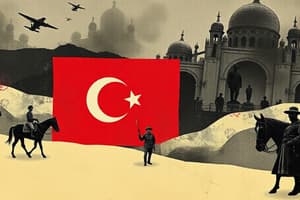Podcast
Questions and Answers
What was the title used for the rulers of the Ottoman Empire?
What was the title used for the rulers of the Ottoman Empire?
- Khan (correct)
- Emir
- Shah
- Sultan
Which Ottoman leader is known for conquering Constantinople?
Which Ottoman leader is known for conquering Constantinople?
- Mehmet II (correct)
- Murad I
- Suleiman I
- Osman
What was the primary military force of the Ottoman Empire composed of?
What was the primary military force of the Ottoman Empire composed of?
- Knights
- Janissaries (correct)
- Militia
- Templars
Which architectural structure is a notable symbol of the Ottoman Empire?
Which architectural structure is a notable symbol of the Ottoman Empire?
What did the Millet System in the Ottoman Empire primarily relate to?
What did the Millet System in the Ottoman Empire primarily relate to?
Who was Hurren Sultan, and what was her significance?
Who was Hurren Sultan, and what was her significance?
What characterized the primary technological advancement during the Ottoman Empire?
What characterized the primary technological advancement during the Ottoman Empire?
Which empire was the primary rival of the Ottoman Empire due to religious differences?
Which empire was the primary rival of the Ottoman Empire due to religious differences?
What notable activity did Suleiman I implement to protect Jews in his territories?
What notable activity did Suleiman I implement to protect Jews in his territories?
During what time period did women begin to take on more power in the Ottoman Empire?
During what time period did women begin to take on more power in the Ottoman Empire?
Flashcards
Ottoman Empire Origins
Ottoman Empire Origins
Founded in 1299 by Osman in Turkey, originally pastoral nomads who converted to Islam and expanded through military conquest.
Janissaries
Janissaries
Elite infantry slave soldiers of the Ottoman Empire, often of Balkan origin.
Mehmet II
Mehmet II
Ottoman sultan who conquered Constantinople in 1453, ending the Byzantine Empire.
Suleiman I the Magnificent
Suleiman I the Magnificent
Signup and view all the flashcards
Millet System
Millet System
Signup and view all the flashcards
Safavid Empire
Safavid Empire
Signup and view all the flashcards
Sultanate of Women
Sultanate of Women
Signup and view all the flashcards
Siege Warfare
Siege Warfare
Signup and view all the flashcards
Blood Libel
Blood Libel
Signup and view all the flashcards
Hürrem Sultan
Hürrem Sultan
Signup and view all the flashcards
Study Notes
Origins and Rise of the Ottoman Empire
- Founded in 1299 in Turkey.
- Initially pastoral nomads, identifying their rulers as khans, utilizing fictive kinship.
- Conversion to Islam and defeat of the Byzantine Empire led to the foundation of modern Turkey.
- Adopted non-nomadic traditions.
- Osman, the founder, initially followed pastoral nomadism.
- Successors expanded the state, moving north into the Balkans.
- The Crusade of Nicopolis (1396) involved a coalition of European forces against the Ottomans.
- Rulers held titles like sultan and shah.
- Janissaries, elite infantry, formed the core of the Ottoman military. These slave soldiers were adept at using weaponry, including primitive muskets, enabling them to reach high ranks. They were born in the Balkans.
- Mehmet II conquered Constantinople in 1453, ending the Byzantine Empire using sieges and advanced weaponry (giant cannons).
Ottoman Military and Expansion
- Continued conquests after Constantinople.
- Suleiman I the Magnificent led the Ottoman Empire to its peak.
- Conquered North Africa and Mesopotamia.
- The Battle of Mohács (1526) saw the Ottomans meet the Habsburg Dynasty.
- The Ottoman Empire attempted, but failed, to conquer Vienna three times.
- Significant conflict with the Habsburgs, Europe's leading dynasty.
- European expansion and development countered Ottoman expansion.
Ottoman Administration, Religion, Law, and Culture
- Developed the Millet System, a religious/ethnic administrative system.
- Religious leaders (e.g., rabbis) headed different communities.
- Suleiman I the Magnificent implemented laws to protect conquered minorities, notably Jews.
- This contrasted with periods of pogroms and blood libels against Jewish communities.
- Ottoman decline is noticeable after the 1800s with a lack of scientific and technological advancements.
- Taqi al-Din built an observatory in Istanbul.
The Sultanate of Women
- Islamic tradition allowed children born to slaves to be free.
- Hurrem Sultan (Roxelana), wife of Suleiman I, held significant influence.
- Women gained increasing power in the late 16th/early 17th centuries.
The Safavid Empire
- The Safavid Empire was a major rival to the Ottoman Empire, differing on religious grounds (Sunni vs. Shia).
- Employed gunpowder technology.
- Shah Abbas was a notable Safavid leader.
- The Chehel Sutun Palace shows a distinction between Safavid (east Asian style) and Ottoman (European style).
Comparing Ottoman and Safavid Technology
- Ottoman technology was characterized as grand, heavy, and imposing.
- Safavid style emphasized harmony and nature in design rather than dominating structures.
Studying That Suits You
Use AI to generate personalized quizzes and flashcards to suit your learning preferences.




